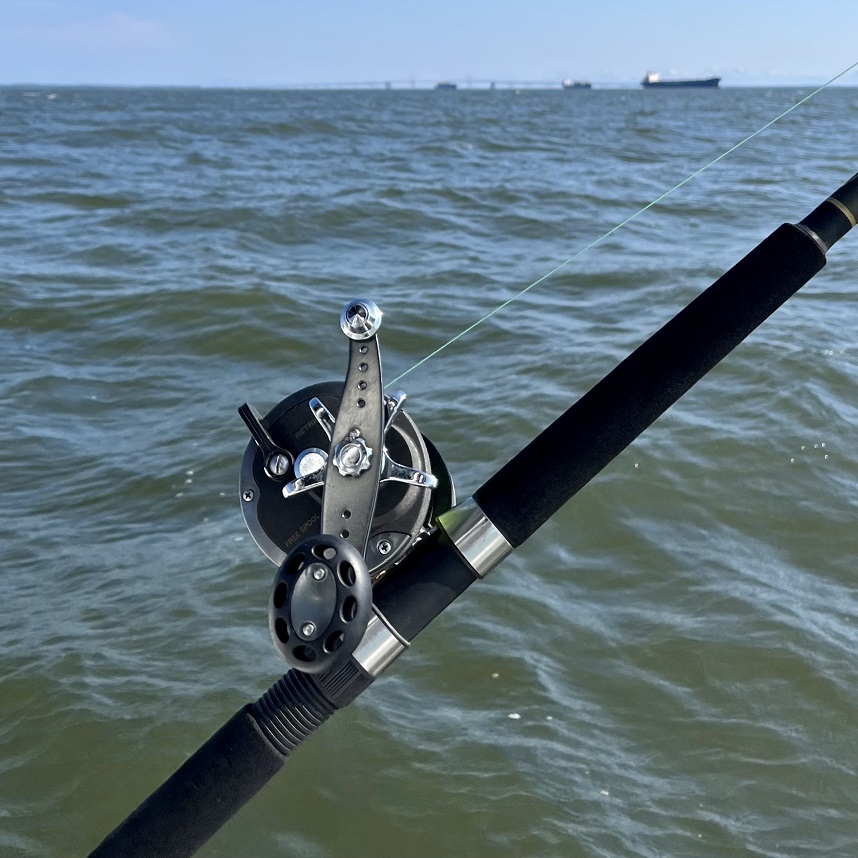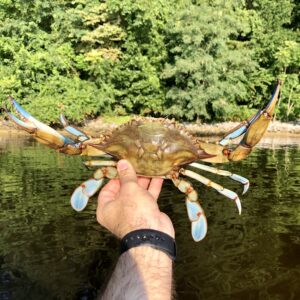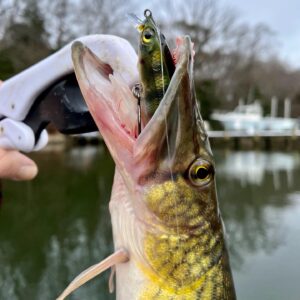Welcome to Reel Chesapeake’s Weekly Fishing Report, our interpretation of what’s biting and where throughout the Chesapeake Bay watershed. Please email us directly at editor@reelchesapeake.com to share updates and photographs of your recent catches for potential inclusion in next week’s column. The leading photograph (above): Trolling #1 or #2 planers with spoons in the middle Chesapeake has been effective for an improved Spanish mackerel and bluefish bite this week. Photo by yours truly.
The past week has been quite busy on Chesapeake Bay waters. Angler reports have been plentiful and offer glimpses of possibility throughout the watershed. Notably, the weather has been stable and will continue the pattern of here ’n there rain sprinkles or quick storms almost daily as we move toward the weekend. But for the most part, sunny skies, manageable winds, and comfortable temperatures have prevailed across the middle region. The evenings have been cooling down to the 60F mark, which has helped the surface water temps dip ever-so-slightly under 80F at dawn. By August 30th, stronger tides will ebb and flood, coinciding with the full moon. In the immediate days following, the highest-water arrives at daybreak and sunset, setting up what could be excellent feeding patterns, especially for those intent on chasing topwater strikes along shoreline (I’m looking at you, striped bass!).
The most exciting reports have been coming from the mouth of the South…River, that is, where cutlass fish have been feeding hard in the Thomas Point vicinity. Anglers have been looking for schools of the fish and when finding them, easily catching the sleek, silver-sided and toothy species by tossing…well…almost anything their way. Most effective have been bunker spoons and 1/2oz jigs with bright paddletails. Look for ospreys circling overhead, picking off fish. And you will, too!
Also of note is an improved Spanish mackerel and bluefish bite in this same area—and extending from Poplar Island and the 80 buoys northward, ever closer the the Bay Bridge (finally!). Fish have generally been in the lower to mid teens, but provide good eating if dispatched, handled, and cleaned efficiently. Most boats are trolling #1 or #2 planers about 50 or so yards off stern with Clark or Drone spoons about another 50 yards behind the planers. Trolling is the way to cover water. But if you luck into a feeding school, cast metals like Kastmasters or rain minnows directly into or just beyond the school and rip that retrieve as fast as you can reel.
We’re still hearing of puppy drum caught in the lower sections of the rivers, such as the Choptank and Severn. Throw swimming plastics as you would for striped bass feeding in the top third of the water column, especially in water 15’ or less and around structure/grass/etc. You could get strikes from the redfish. Most are just short of slot size.
Anglers departing the Solomons/Potomac/Point Lookout region are having success for these species, plus a mix of speckled trout. And the further south you venture, the better the chance to hook into bull reds, which the charter fleet is generally chasing right now. It’s all about big reds, stripers, and cobia (if you’re lucky) with all species coming on classic larger 7” jig/plastic combos.
In the tributaries, I recommend going for the continuously improving schoolie bite during the magic hours (sunrise, sunset). If the water is glass, try walking lures; if it’s rippling from a slight wind, try poppers; and if winds approach 10–15 knots, subsurface lures may be best. When the sun is overhead, move on to white perch, which remain plentiful, even far upriver. All the mid bay rivers are producing right now, so if you have the ways and means to be on the water at the right time, you should be able to find the right places where these species stage: sandbar points, bridge pilings, pinch points along the river stem, any visible riprap, underwater oyster bars, rapid depth changes, shade, etc. These will hold fish and with the stronger tides due this coming week, we should hopefully have some improved current moving across and around this structure/cover.
On the Eastern Shore, we directly heard a few very good crabbing reports. The crabs are running well in the lower to mid Choptank, as well as the Wye and Tred Avon. Crab a trotline in 5–8’ on a dropping tide and you could have yourself a day.
In fresher environs, largemouth bass and northern snakehead remain attractive. And the fluke bite has improved for both species according to several anglers. All the cuts, ponds, and adjacent streams of the middle Patuxent hold these fish. We have fun in the Bowie vicinity south to Jug Bay. But anglers fishing the tribs of the lower Pax are catching, too. The Potomac tribs south of D.C. hold the largest specimens though. Ditto for blue catfish, which are caught on chunk bait bottom rigs. Try the bridge parks along the Anacostia River. Another opportunity to try for big blues exists north, at Fort Smallwood Park near the mouth of the Patapsco River—chunk from shore at the point/grass picnic area directly in front of the old rampart.
And, of course, now is as good a time of the year as ever to take your littles to the local impoundments for some bluegill fishing. My son and I visited Annapolis Waterworks Park this past weekend and fished the spillway with a simple bobber rig and earthworms on a small #6 octopus hook. Just about every cast was a catch. What a hoot! Good luck!
This report appears within On The Water magazine’s weekly collection of Chesapeake Bay fishing reports.






